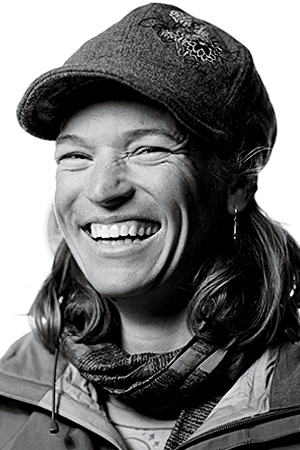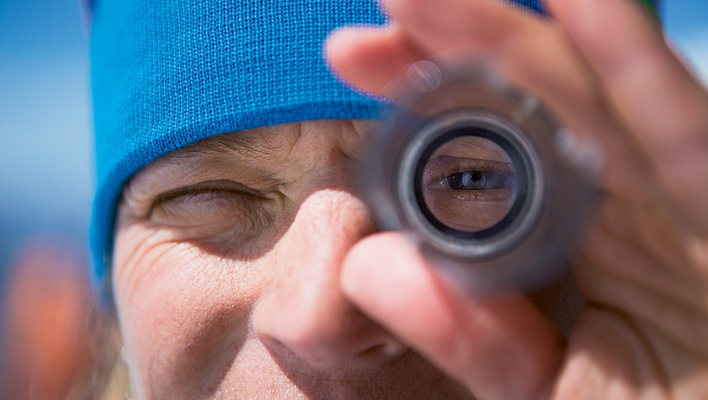Knowledge is power and, in the mountains, it leads to powder. But getting there and doing it safely takes time, practice and lessons both formal and not. And this year’s Skills Guide is a platform from which to dip a toe into the off piste, the impetus to dive headlong into a backcountry education or an opportunity to refresh and rethink personal processes. Because no matter your background, there’s always more to learn. And, just like traveling through the mountains, there’s pleasure in the pursuit.
—
Sarah Carpenter, an AMGA guide and co-owner, guide and educator with the Victor, Idaho-based American Avalanche Institute, believes in the art of the checklist and geeking out on snow science. Here are a few of her lessons in her own words.

Sarah Carpenter is happy and at home in the mountains of Idaho. [Photo] Mark Fisher
On Learning
For an entire winter, while I was ski patrolling at the Yellowstone Club, I was under the mentorship and watchful eye of Tom Leonard. I stood in snowpits with him, did transceiver searches with all sorts of beacons, mapped avalanche paths and built bomb trams. He made space for me to ask questions and learn from him and from experience. It was a great stepping-stone in my career.

Sarah Carpenter keeps focused on safety. [Photo] Jim Harris
On Risk
I don’t want to get injured or killed in the backcountry, nor do I want anyone I’m with to get injured or killed. I don’t think it’s the acceptable risk that shifts as much as the terrain management and experience that change. My skill set in the mountains is different from my clients’, so what I can do in the mountains on my own looks different from what I might do with clients.
On Communication
I love using the AAI Backcountry Checklist, which is a tool students get when they take a course from us. It’s a systematic approach to planning, executing and debriefing a tour. It’s an objective tool that can prompt those difficult questions. I find it a great way to make sure that no steps are skipped.
On Turning Around
Again, I use the checklist that AAI developed over the last five years. I ask: Do the conditions match the forecast? Does our route match our pre-trip plan? Are we seeing any obvious signs of instability? How are we doing as a team? If anything feels off, I change the objective. It can be really hard to do, but it’s a heck of a lot better than taking a ride and getting injured or killed.
On Picking Partners
This is such an important thing to think about that often gets overlooked. If I’m getting to know someone, I travel in mellow terrain that’s not committing. If I haven’t toured with someone before, I never ski a committing objective with them. I want to tour with someone I’m comfortable communicating with and someone I have fun with. I also like to understand the risk tolerance of my partner as compared to my own—it’s a good tool to figure out if we are a good team.
On Trip Prep
Aside from the AAI checklist, I lay out my gear and review what I have and what my partners have. I want to make sure that I’m self-sufficient each day I’m out touring. I hope to never use my rescue sled and repair kit, but I always have these with me for those unplanned emergency situations.
On Skills
We all want to geek out on the science, but group dynamics and communication impact backcountry experiences more often than surprise snow conditions. Knowing how to communicate and work as a team is essential. I make sure I have a plan before I leave my house. I also make sure I’m on the same page with my partners regarding this plan before leaving the trailhead. The key to success with communication is making sure that everyone has a voice, and that everyone’s opinion matters. It matters when we’re planning a day, as well as when we’re out in the field. When I’m in the field, one question I like to ask is, “Are you seeing something different from [what] I’m seeing?” and, “What am I missing?” This gives others space to offer up their observations.
On Snacks
I love to bring prosciutto, almonds and hot tea in the winter. I also really enjoy something sweet, like licorice or an orange.










Great to know that someone knows what the hell there talking about. Thanks Sarah. I appreciate common sense and just plain smart.